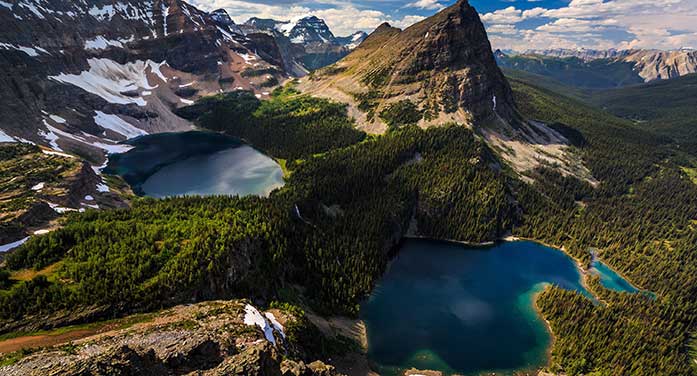Another casualty of the disappearance of glaciers in the Canadian Rockies is the vanishing of the iconic turquoise of glacier-fed alpine lakes, according to a University of Alberta limnologist who documented the unfortunate change in the latest look at the health of Canada’s mountains.
In an essay written for the fourth annual State of the Mountains Report by the Alpine Club of Canada, Rolf Vinebrooke, a biology professor in the Faculty of Science, outlined the forces that alter the colour of mountain lakes and the consequences that go beyond the fading hue.
The main concern for Canada’s alpine lakes is what researchers have coined as “clarification.”
Vinebrooke explained that melting glaciers erode the rock material beneath and send that material – often referred to as glacial flour because it looks like baking flour – into the mountain lake below. From there, this rock flour reflects and scatters sunlight in such a way that it creates a hypnotic milky turquoise colour.
“With glaciers shrinking or disappearing altogether, the amount of rock flour flowing into mountain lakes is diminishing, so we’re seeing these lakes take on a translucence or pure blue hue,” he said.
Vinebrooke’s lab documented this transformation using archival photographs of alpine lakes, particularly those along the Icefields Parkway through Banff and Jasper, as well as core samples taken from the bottom of lakes.
“If you look back in the sediment record of a lot of lakes that are currently clear blue mountain lakes, during the mid-20th century, the sediments used to look a lot more like white clay,” said Vinebrooke. “In the span of only a decade or so, suddenly the top of that white clay sediment is a layer of blackish-brown material that you see in the mud of most lakes.”

An aerial view of Egypt Lake in Banff National Park. As disappearing glaciers deposit less flour-like sediment into alpine lakes, the colour of the water changes from milky turquoise to a more pure blue. (Photo: Clark Monson)
Vinebrooke said examples of this clarification event can be found in Jasper’s Curator Lake, the Geraldine Lakes, which are a full day’s hike west of the Icefields Parkway, and McConnell Lake in the remote northeast corner of Banff.
Two other climate change-related colour changes Vinebrooke writes about are the greenification of lakes due to a diffusion in plant-like algae fuelled by an uptick in wildfire- and industry-produced nitrogen and phosphorus, and the brownification of lakes, a byproduct of accelerated soil decomposition brought on by warmer temperatures.
“The rate at which some of these lakes have changed when they’ve historically been fairly stable for the centuries since post-glaciation attests to the fact that something is happening, and it’s happening on a pretty fast scale,” said Vinebrooke.
He added that, with all these factors at play, it would be very hard to identify a mountain lake as being “pristine.”
“It all points to potential deterioration of water quality in some of these lakes that have always been considered the perfect example of pure water, with the worst-case scenario being these lakes see a cyanobacteria or a blue-green algae problem like we’re seeing down here at lower elevations, or in some mountainous areas found in the U.S. and Europe.”
Heading up the State of the Mountains report for the fourth straight year are U of A mountain historian Zac Robinson from the Faculty of Kinesiology, Sport, and Recreation, David Hik from the Department of Biological Sciences and chief scientist of Polar Knowledge Canada and Lael Parrott, a professor of sustainability at the University of British Columbia, Okanagan.
Robinson said with the public health crisis dominating the past two years and the climate crisis intensifying, the theme for this year’s report was an easy choice: resilience.
The feature article this year is all about how the mountain community of Revelstoke, B.C., is showing resilience in the face of the tourism-crushing pandemic.
“The pandemic exposed vulnerabilities and inequities, but also showed there is an increased need to be more compassionate and caring.”
And just like mountain communities changed to deal with the threat the pandemic brought, Robinson said a similar thrust is needed to protect Canada’s alpine areas.
“The pandemic has reminded us how fortunate we are to have these iconic wilderness spaces. By highlighting the rapid changes occurring in our mountains, our hope is that we might be able to inspire increased support for the protection and conservation of these special places, from coast to coast to coast.”
Other U of A authors who contributed to the report include Colleen Cassady St. Clair in the Department of Biological Sciences, who described the efforts of her team working with the Canadian Pacific Railway and Parks Canada to reduce train-caused mortality of grizzly bears in the parks; and Liza Piper, an environmental historian in the Department of History and Classics, who took a timely look back at coal policy on the Eastern slope.
“You don’t have to be from the mountains to care for these places,” said Robinson. “The COVID-19 pandemic is a stark reminder that all places on the planet are connected.”
| By Michael Brown
This article was submitted by the University of Alberta’s Folio online magazine. The University of Alberta is a Troy Media Editorial Content Provider Partner.
© Troy Media
Troy Media is an editorial content provider to media outlets and its own hosted community news outlets across Canada.

